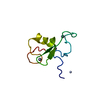+Search query
-Structure paper
| Title | Mechanism of polyubiquitination by human anaphase-promoting complex: RING repurposing for ubiquitin chain assembly. |
|---|---|
| Journal, issue, pages | Mol Cell, Vol. 56, Issue 2, Page 246-260, Year 2014 |
| Publish date | Oct 23, 2014 |
 Authors Authors | Nicholas G Brown / Edmond R Watson / Florian Weissmann / Marc A Jarvis / Ryan VanderLinden / Christy R R Grace / Jeremiah J Frye / Renping Qiao / Prakash Dube / Georg Petzold / Shein Ei Cho / Omar Alsharif / Ju Bao / Iain F Davidson / Jie J Zheng / Amanda Nourse / Igor Kurinov / Jan-Michael Peters / Holger Stark / Brenda A Schulman /    |
| PubMed Abstract | Polyubiquitination by E2 and E3 enzymes is a predominant mechanism regulating protein function. Some RING E3s, including anaphase-promoting complex/cyclosome (APC), catalyze polyubiquitination by ...Polyubiquitination by E2 and E3 enzymes is a predominant mechanism regulating protein function. Some RING E3s, including anaphase-promoting complex/cyclosome (APC), catalyze polyubiquitination by sequential reactions with two different E2s. An initiating E2 ligates ubiquitin to an E3-bound substrate. Another E2 grows a polyubiquitin chain on the ubiquitin-primed substrate through poorly defined mechanisms. Here we show that human APC's RING domain is repurposed for dual functions in polyubiquitination. The canonical RING surface activates an initiating E2-ubiquitin intermediate for substrate modification. However, APC engages and activates its specialized ubiquitin chain-elongating E2 UBE2S in ways that differ from current paradigms. During chain assembly, a distinct APC11 RING surface helps deliver a substrate-linked ubiquitin to accept another ubiquitin from UBE2S. Our data define mechanisms of APC/UBE2S-mediated polyubiquitination, reveal diverse functions of RING E3s and E2s, and provide a framework for understanding distinctive RING E3 features specifying ubiquitin chain elongation. |
 External links External links |  Mol Cell / Mol Cell /  PubMed:25306923 / PubMed:25306923 /  PubMed Central PubMed Central |
| Methods | EM (single particle) / NMR (solution) / X-ray diffraction |
| Resolution | 1.755 - 23.0 Å |
| Structure data |  EMDB-2775:  EMDB-6084:  PDB-2mt5:  PDB-4r2y: |
| Chemicals |  ChemComp-ZN:  ChemComp-HOH: |
| Source |
|
 Keywords Keywords | METAL BINDING PROTEIN /  Ring domain / zinc binding domain / Ring domain / zinc binding domain /  LIGASE / LIGASE /  E3 Ubiquitin Ligase E3 Ubiquitin Ligase |
 Movie
Movie Controller
Controller Structure viewers
Structure viewers About Yorodumi Papers
About Yorodumi Papers




